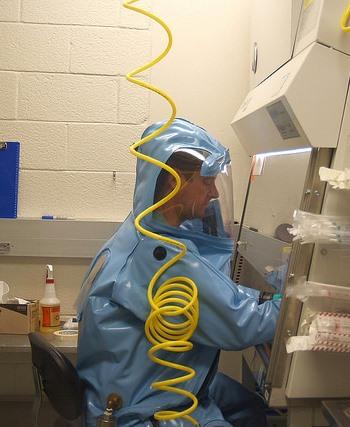A study today in the New England Journal of Medicine shows that ZMapp, the promising treatment for acute Ebola virus disease, narrowly missed the statistical threshold but demonstrated high efficacy after being used on 72 patients during the 2014 to 2016 Ebola outbreak in West Africa.
The study was a randomized control trial called the PREVAIL I, or the Partnership for Research on Ebola Virus in Liberia. In order to be considered statistically significant and a viable treatment option, researchers from the National Institute of Allergy and Infectious Diseases (NIAID) needed to demonstrate that treatment with ZMapp (in addition to the current standard of care) was better than the current standard alone 97.5 % of the time. In these 72 patients, ZMapp demonstrated efficacy 91.2% of the times.
"I would view the results from this study in an optimistic light," said Richard Davey, MD the deputy clinical director of NIAID and the lead author on the study. "We were able to show that there was a greater than 90% probability that the drug had efficacy."
ZMapp, three monoclonal antibodies directed against the surface glycoprotein of Ebola virus, is an intravenous infusion based on body weight given three times, once every 3 days at the start of symptom onset. In non-human primate studies, it was shown to be effective at preventing death from Ebola.
Fewer deaths in small trial
The patients were found in Ebola treatment centers and hospitals in Liberia, Sierra Leone, Guinea, and the United States. Twenty-one of the 72 patients died, a case-fatality rate of 29%. Thirteen of the 35 patients (37%) who received only standard care died, while 8 of the 36 people (22%) who received ZMapp plus standard care died.
Patients were enrolled from March to November 2015. ZMapp treatment began within 12 to 24 hours of trial enrollment, and clinical status was recorded daily for 4 weeks, with a final check on day 58.
"We were not able to enroll the desired number of patients," said Davey, who said that 100 patients in both the treatment and control arms of the study would have conferred greater power.
Seven out of the 8 deaths in ZMapp patients happened on or before day 4 of the trial, which was before the second of three planned ZMapp infusions. Additionally, the authors of the paper note that ZMapp recipients likely received their first infusion after the 5-day window of symptom onset that conferred a higher survival rate in non-human primate trials.
The Ebola outbreak that began in West Africa in 2014 was the largest in history, with 28,000 suspected and confirmed cases of Ebola and more than 11,000 deaths. But by the time the trial began, emergency public health measures were already reducing the number of cases.
Davey said the fact that researchers were able to conduct a randomized control trial amidst the outbreak of such a lethal disease is in itself a victory. "This can be a useful model for future diseases and outbreaks."
Mapp pharmaceutical, the makers of ZMapp, has a supply of the drug, which will be made available to Ebola patients in Liberia, Sierra Leone, and Guinea in an emergency access program once they the drug has passed each country's regulatory approval processes.
In their conclusion, the authors of the study note that the use of ZMapp could save as many as 15 lives for every 100 patients treated.
See also
Oct 12 N Engl J Med study
Feb 27, 2015 CIDRAP news story, "Trial of Ebola drug ZMapp launches in Liberia, US"


















